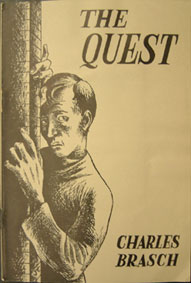England II
Edith Joy Scovell (1907-1999) was perhaps the only English poet Brasch knew well at Oxford. She studied at Somerville College, and later married the ecologist Charles Sutherland Elton in 1937. Her poetry is fused with references to the landscapes of the places she lived in, such as the West Indies and the rainforests of Central and South America. In later life, she began translating the work of the Italian Giovanni Pascoli, an activity that Brasch would have empathized with. The River Steamer (1956) is her second book, containing poems that link nature with human mortality.
|
Before he left England in 1945 Brasch wrote the script for a mime play, The Quest, which was published by The Compass Press, a small group headed by the English painter and designer John Crockett. The plot, which parallels Brasch's general position at the time, is about an individual seeking his place in the world. Crockett supplied the cover design. |
 |
Charles Brasch, The quest: words for a mime play. London: Compass Players, 1946. |
In 1940 John Lehmann accepted three poems by Brasch for his Folios of New Writing, including 'In these Islands'. In 1941, the initial form of Brasch's 'In these Islands' was also accepted into another of Lehmann's publications, Penguin New Writing. Brasch was extremely pleased that his poems appeared with such luminaries as Spender, Auden and C Day Lewis. As he wrote: 'It was a declaration to the world that I was a poet, that I had not lived in vain.'
 |
| In classical mythology, Bellerophon attempted to fly the winged horse Pegasus to Mount Olympus. Dismounted by Zeus and crippled in the fall, Bellerophon spent the rest of his life wandering the earth. Brasch wrote that 'the centre of the Republic of Man… is a mountain range whose highest summit is the peak of Parnassus. Literary journals seldom glimpse that summit…their activity lies chiefly in the foothills.' Brasch's personal bookplate represents this desire to aim high, with any attempt surely better than none at all. To date there is no information on who designed this bookplate or when it was commissioned. |
| Eric Gill, sculptor, printer, writer and designer spent his last twelve years at Piggotts, Spleen, near Lacey Green, Buckinghamshire. Brasch lived at nearby Missenden Abbey and met Gill and his family there. However, Gill's influence was evident earlier. Up to 1933 Brasch signed his own books with the conventional 'C. O. Brasch.' After 1933, the 'CB' cipher, similar to Gill's unforgettable example, was to be the major way in which Brasch depicted ownership in his books. |
|
| "CB" |
Next >